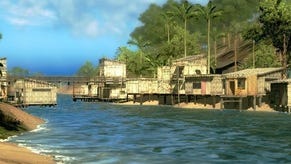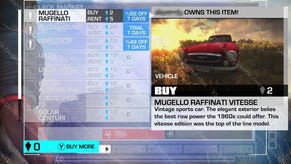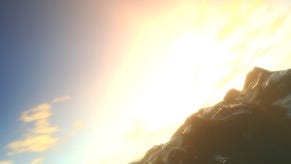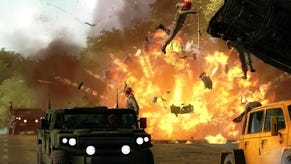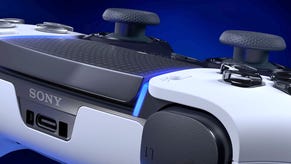Just Cause 2 performance showdown
The demo put through its considerable paces on PS3 and Xbox 360.
Just Cause 2 is a game that pushes all the right buttons for us here at Digital Foundry. Proprietary engine? Check. Scandinavian developer? Check. Colossal open world? Ingenius physics-based gameplay? Epoch-making pyrotechnics? Check, check, check!
The arrival last Thursday of demo code for PlayStation 3 and Xbox 360 gives us our first chance to properly evaluate the technology and performance of the respective console versions within the DF lair, away from the compromises of compressed internet video.
Not that Avalanche's various gameplay vids aren't worth checking out, mind you: they effectively showcase the range of gameplay possibilities made possible by the tech.
It's exciting stuff - not just gamers, but for other game-makers too. On a recent DF visit to a developer currently working on a triple-A title, Avalanche's videos were being showcased at a team meeting on a 50" plasma. Interestingly this presentation wasn't about polygon counts, LOD biases or framebuffers. They were checking out the footage because Just Cause 2 looked like fun to play.
Central to the game's appeal is the inclusion of an extremely long grappling hook. You use it to winch yourself onto just about anywhere within the huge environments, or else to effortlessly hijack speeding vehicles.
Its offensive capabilities are impressive too. Sure, you can use it to pull opponents towards you, but the ingenuity of the grapple-gun comes down to its ability to link enemies and objects together. Attaching your opponent to a barrel that's about to explode has its appeal, as does connecting them to a passing vehicle.
Beyond the grappling, the key appeal of this game is its environments, and this is where the technology Avalanche has been working on comes to the fore. The rendering distance of the gameworld is absolutely colossal, with an impressive level of detail retention even in the most faraway areas. Jump into a chopper to reach stratospheric heights and check out the view: this sort of stunt was impressive in the first Just Cause, but it's been taken to a new level in the sequel.
The overall feel of the game is bolstered by an impressive lighting model, with smooth atmospheric effects. Transparency elements such as particles, clouds and explosions look very smooth indeed. Despite the 34 square kilometres of gameplay world available in the demo, water sources within the playable area are hard to locate (the available play area is so vast, we're still looking). How Avalanche has handled this effect in both of the console builds will be interesting to see.
Early impressions are that PlayStation 3 and Xbox 360 owners have been well-served by Avalanche's code-smiths. However, it is curious to note that while overall the similarities between the console games outweigh the differences by quite a margin, Avalanche has chosen two different approaches to the performance aspect of Just Cause 2. The headline news here is that the Xbox 360 version can drop v-sync while the PS3 game does not.
Let's kick off with a performance analysis of the Xbox 360 version.
Few surprises here. Avalanche has capped frame-rate at 30FPS. In order to maintain fluidity and consistency in response, when the game engine struggles, v-sync is lost and torn frames enter the equation. In the course of this video a mere eight per cent of the 60Hz output of the Xbox 360 consists of torn frames. Cut-scenes apart (which both consoles struggle with in their own way), the game only really seems to suffer when big explosions kick-off.
There's no problem at identifying the core attributes of the framebuffer here. Just Cause 2 on Xbox 360 has the full, requisite 1280x720 and implements 2x multisampling anti-aliasing.
Now let's turn the focus to the PlayStation 3 rendition of the demo.
Here we see a very different FPS graph owing to a change in the rendering attributes of the Avalanche engine running on PlayStation 3. The game maintains v-sync throughout, making for a higher consistency in image quality as you play. Also note that the PS3 game runs without a frame-rate cap while overall maintaining an average just a notch below 30FPS - just like Xbox 360.
It's not the first time we've seen v-sync/tearing differences like this before, of course. Resident Evil 5 had a similar setup, albeit without the unlocked frame-rate. Why Avalanche has gone with two separate approaches like this is curious: it may well have been the case that performance of both platforms was analysed and the best was chosen for each according to how the engine performed on each architecture.
In terms of image quality, Just Cause 2 appears to use 2x quincunx anti-aliasing, though this is not conclusive owing to the fact it appears to be used relatively sparingly - some edges get smoothed, some do not. Getting a good reading is also made more difficult owing to the way bloom is deployed, and there's plenty of it in Just Cause 2.
Another interesting difference concerns the shadow-rendering. Low-resolution shadows with obvious serrated edges close-up can be seen on both versions of the game, though these serrations are a touch smoother and more refined on PlayStation 3. More obvious is that the inclusion of a camera-based motion blur only appears to have been implemented on the Xbox 360 game
Other elements of the engine appear to be pretty much like-for-like on both console platforms. There's fairly well handled geometry LOD popping on trees and shadows - it usually happens so far away that the eye doesn't really pick up on it. Depth-of-field seems to mask foliage as it transitions into a lower resolution alpha texture.
Bearing in mind how colossal this gameworld is, and how much of it you see, perhaps the biggest question mark remaining concerns just how Just Cause 2 plans to stream its data. Mandatory install on PS3? Lower performance running from DVD on Xbox 360? What about load times?
These are the sorts of thing we'll be looking at in the forthcoming Face-Off. We'll also be factoring in the PC version of the game too. Avalanche is looking to offer plenty of goodies for PC owners with NVIDIA graphics cards: there's 3D Vision compatibility, plus promised support for the GPU-specific programming language, CUDA. And Avalanche is promising an impressive battery of visual effects for CUDA-capable GPUs, which we're looking forward to checking out in the final game.
Just Cause 2 is due out for PC, PS3 and Xbox 360 on 26th March.



